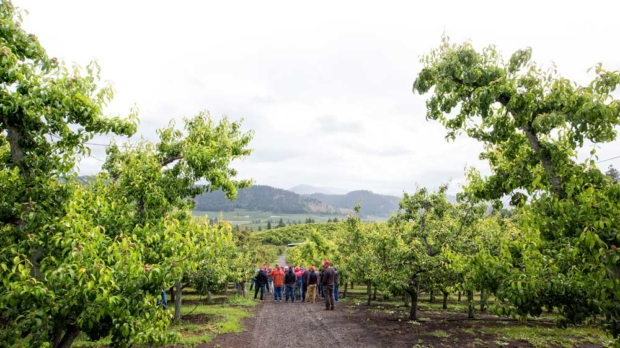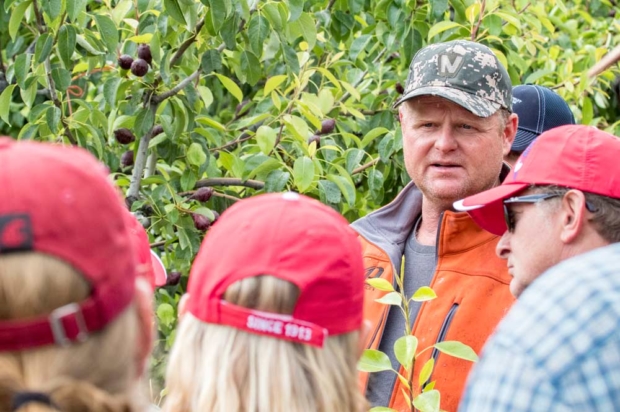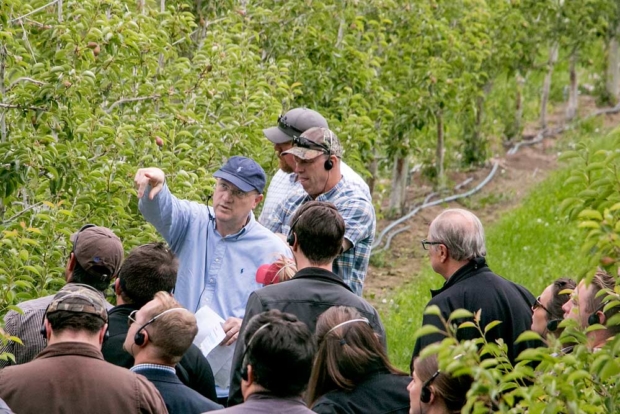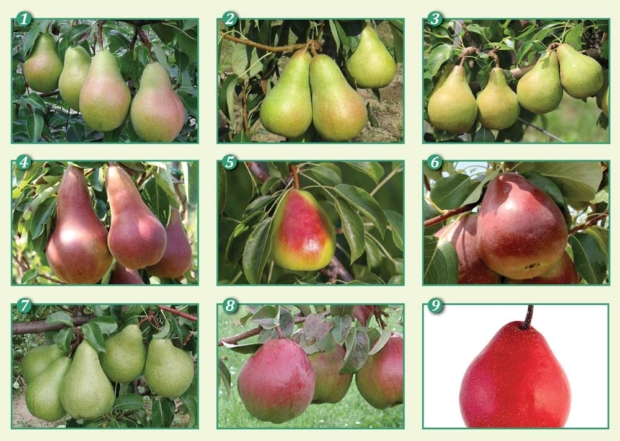
Limited rootstocks, varieties from the 1700s, truncated markets and a decade-long production flatline.
The global pear industry is vexed by challenges.
In search of answers, pear producers from around the world gathered in Wenatchee, Washington, for the 10th annual Interpera conference, marking the first time the group has met in the United States.
Pear growers in Washington and Oregon produce 84 percent of the U.S. fresh pear crop, thanks to hot summer days, cools nights and irrigation from the mountain snowpack of the neighboring Cascade Range.
Washington alone produces half the U.S. fresh crop, most of it in the state’s central Wenatchee Valley.
“It’s the place to grow pears,” said Rudy Prey, a Wenatchee Valley grower on the forefront of converting to high-density orchards. “There’s no doubt about that, with the climate, the elevation, and we have a good supply of water.”

Interpera organizers wanted to give their global membership a close-up view of the premier region.
“For us it’s very important to develop and to move Interpera around the world,” said Manel Simon Barbero, a founder of Interpera and general manager of Afrucat, a fruit association in Catalonia, Spain. “The U.S.A., and especially your area Wenatchee, is an important area of pear production.”
About 150 people attended Interpera — also called the World Pear Congress — for presentations and tours to learn how industry leaders are trying to overcome the obstacles that have held production to a plateau for about 10 years.
In all regions except China, production has remained steady even though world population has grown by 14 percent, said Kevin Moffitt, president and CEO of the Pear Bureau Northwest, the Portland, Oregon-based nonprofit marketing organization that represents the 1,600 pear growers of Oregon and Washington.
China, the world’s largest producer by several times, is on a completely separate scale.
The giant has seen a rapid increase in pear production, but grows Asian varieties not produced or marketed widely in the rest of the world, which focuses on European pear varieties.
Market dynamics aren’t really helping either, especially since Russia’s 2014 ban on European and U.S. agricultural products.
The closure has taken away one of the primary export markets for European producers; Belgium, for example, previously exported 39 percent of its pears to Russia. Simon Barbero likened the loss of Russia to losing one finger from your hand.
In the U.S., unlike some other parts of the world, growers lack a true, dwarfing rootstock that allows them to more easily produce compact, high-density orchards that lend themselves to mechanization, uniformity and higher yields. (Read “The quest for new varieties, cold-hardy rootstock” from Good Fruit Grower’s Interpera coverage.)
And still, due to high production levels in the Pacific Northwest, the U.S. remains the world’s second largest producer of pears behind China, making the region a key spot for international pear growers to learn more about the industry.
A day in the field
Half the two-day Interpera conference involved tours and field day lessons in packing houses and orchards west of Wenatchee along the rushing Wenatchee River, flanked by evergreen-covered hills and arid rock formations, where growers learned how to grow as compact and dense a canopy as possible without dwarfing rootstocks.

In a fourth-leaf Monitor, Washington, orchard owned by McDougall & Sons, Washington State University horticulturalist Stefano Musacchi taught conference-goers his bi-axis system, which employs a narrow canopy with two main leaders.
The training method controls vigor and allows for double the number of shoots as a tall spindle system, while distributing light and fruit more evenly throughout the canopy. He suggested leaving at least 20 to 25 small branches — or feathers — on each axis.
The system requires a trellis structure with four wires and can be started from nursery plants, heading existing trees or in the field with top grafting. In its Monitor orchard, McDougall top-grafted the trees.
A 12-foot by 4-foot spacing works well in the Pacific Northwest with rootstocks Old Home by Farmingdale 87 and 97, he said.
He also demonstrated “click” pruning, a method of tipping branches of 1-year-old wood, leaving two to three vegetative shoots to regrow with vigor and to minimize blind wood and maintain a compact canopy.
Musacchi advocates the same method for certain apple varieties, including the new WSU variety branded as Cosmic Crisp.
Albino Guzman, the orchard manager, told growers he carefully trains his crews in the click method rules.
At Prey’s scenic 75-acre orchard near Leavenworth, so close to the forest that bears occasionally visit, trial and error have driven his modernization efforts.
Prey, a second-generation grower, has gradually made his plantings more dense over the years, stopping at 14 by 2 feet because his hilly terrain won’t allow for much more.
He favors not using trellises after snow toppled one during an unusually harsh winter. Pear trees seem to stand on their own in his heavy soil, he said.
He plants his trees straight up and down, and after three years pulls them in alternating directions to get a V-shape, tying the branches to each other overhead to maximize light exposure.
Switching to a high-density planting makes his whole operation efficient. Everything is cheaper and quicker.
“I like to be able to produce a bin of pears for $50 less than the traditional low-density style,” he said. •
Newer pear varieties

Here’s a glimpse of some of the newer pear varieties discussed at Interpera.
Four Italian varieties were released by the University of Bologna in Italy, where Washington State University’s Stefano Musacchi still supervises the breeding program.
Early Giulia (1) is early ripening, sweet and crispy; Lucy Sweet (2) has an aromatic flavor with with both melting and juicy-crispy texture; Debby Green (3) has melting flesh, a balance of sweetness and acidity and grows on a compact tree; Lucy Red (4) has a sweet flavor with red skin, Musacchi said.
Gem (5) is a U.S. Department of Agriculture variety prized as productive, nonrusseting and fire blight tolerant. It also can be eaten crispy right off the tree or ripened to a melting texture, said Todd Einhorn, Michigan State University plant physiologist.
Three Belgian varieties, described by Jef Vercammen, director of a Belgian fruit growing research station: Celina/QTee (6) is a productive pear with good fruit size that is only a little susceptible to fire blight but is susceptible to frost; Cepuna/Migo (7) has good production with large fruit size, stores well and exhibits almost no russeting. Sweet Sensation (8) is a club variety that performed well on grower taste tests and good fruit set.
PremP009 (9), a New Zealand variety that carries the brand name Piqaboo, was discussed by breeder Lester Brewer. It’s a conventional hybrid cross of European, Japanese and/or Chinese pears that rated higher in taste tests with Chinese consumers than the Asian pear Hosui.
—by Ross Courtney






Leave A Comment